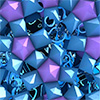| May 22, 2023 |
|
(Nanowerk News) Batteries play a crucial role in powering many modern devices, such as mobile phones, pacemakers, and electric vehicles. Yet, traditional lithium-ion batteries pose limitations such as safety risks, short life cycles, and long charging times. The pioneer niobium-graphene batteries developed by the Centre for Advanced 2D Materials (CA2DM) at the National University of Singapore (NUS), an innovator in the research of graphene and other 2-dimensional (2D) materials, and CBMM, the global leader in niobium products and technology, will address all these problems.
|
|
The batteries are being tested at the new CBMM-CA2DM Advanced Battery Laboratory which was launched today by NUS and CBMM and established with a joint investment of USD3.8 million (S$5 million) over three years, supported by the National Research Foundation, Singapore.
|
|
“The CBMM-CA2DM Advanced Battery Laboratory is the most high-tech and well-equipped facility in Singapore to explore new frontiers in battery technology. The lab provides researchers with advanced equipment to create new solid electrolytes, fabricate various cell forms, and eventually put their innovations to the test. We have made significant progress in our development of niobium-graphene batteries which are proving to be a game changer in safety, efficiency, and sustainability,” said Professor Antonio H. Castro Neto, Director of CA2DM.
|
Rethinking battery capabilities
|
|
The pioneer niobium-graphene batteries have proven to have greater performance and safety compared to traditional lithium-ion batteries. In addition, volatile and flammable liquid electrolytes in lithium-ion batteries will be replaced by niobium-containing solid electrolytes, further enhancing the novel batteries’ safety and energy density.
|
|
Benefits of niobium-graphene batteries include:
|
|
Niobium serves as the primary active material in the negative electrode of the batteries while also being used as an additive in the positive electrode. Graphene, on the other hand, is utilised in both negative and positive electrodes to boost electronic conductivity and structural stability. In the negative electrode, the unique crystal structure of niobium materials facilitates rapid charging without damaging the structure. In the positive electrode, niobium materials can increase ionic conductivity and safeguard the active material from degradation. Additionally, the low-density nature of graphene significantly improves the electronic conductivity of both electrodes without compromising the overall energy density of the battery.
|
|
The final prototype of the niobium-graphene battery is expected to be completed in the first quarter of 2024.
|
|
“As they have a longer lifespan, the new graphene-niobium batteries significantly reduce total cost of ownership compared to existing lithium-ion batteries and have ultrafast charging capabilities. In addition, they offer higher safety as they do not risk explosion even in high temperatures,” said Rogerio Ribas, CBMM Global Head of Batteries. “The first batteries to combine niobium applications on both cathode and anode, they also have advantages such as higher input and output power, wider temperature operating range and higher state of charge thus can be developed for specific markets such as commercial and industrial applications including regenerative braking systems for hybrid vehicles (rails, trucks, and passengers cars), heavy-duty applications, intralogistics, cordless power tools among others,” adds Mr Ribas.
|
|
The new laboratory is equipped with state-of-the-art facilities for both research and manufacturing of advanced niobium-based batteries and solid electrolytes. Due to their high-performance capabilities, the niobium-graphene batteries have wide-ranging potential applications, including medical devices, such as pacemakers and defibrillators, and aerospace equipment, such as satellites and spacecraft, all of which require long cycle life and high safety standards. Other potential applications include electric vehicles, and consumer electronics.
|
|
“With the increasing need for sustainable and high-performance energy solutions, the CBMM-CA2DM Advanced Battery Laboratory marks a strong partnership between enterprise and research with exciting real-world applications. At NUS, we constantly seek to push the boundaries of innovation, and we look forward to the lab’s novel contributions to science and technology, as well as the industry,” said Professor Chen Tsuhan, NUS Deputy President (Innovation and Enterprise), and Chairman of the CA2DM Board.
|
Poised for further breakthroughs in battery technology
|
|
The CBMM-CA2DM Advanced Battery Laboratory is the first of its kind in Singapore that is equipped end-to-end for customised battery creation and testing. Key features of the lab include an electrolyte processing unit, and a dry room with humidity going as low as one percent, which enables the handling of moisture-sensitive battery materials. The dry room is also seamlessly linked to a series of gloveboxes that create an inert atmosphere for the batteries to be assembled. This ensures zero contamination throughout the process.
|
|
The lab design also allows for thousands of prototypes to be tested per month. The laboratory houses advanced battery testers that can carry out charge and discharge cycles, investigate working and degradation mechanisms, and predict the durability of the batteries produced. In addition, the lab has equipment that allows researchers to fabricate various forms of battery cells, such as coin and pouch cells, in different dimensions.
|
|
Going forward, the lab aims to test and create more advanced and novel batteries with various materials and interact with the local research institutes, faculties, and industry to develop frontier technology in batteries. One high-tech target is to develop solid-state battery technology which does not require any flammable liquids inside, making it completely safe. An industrial space will also be created within the lab to allow external companies to develop and test battery prototypes to fulfill their commercial needs.
|

